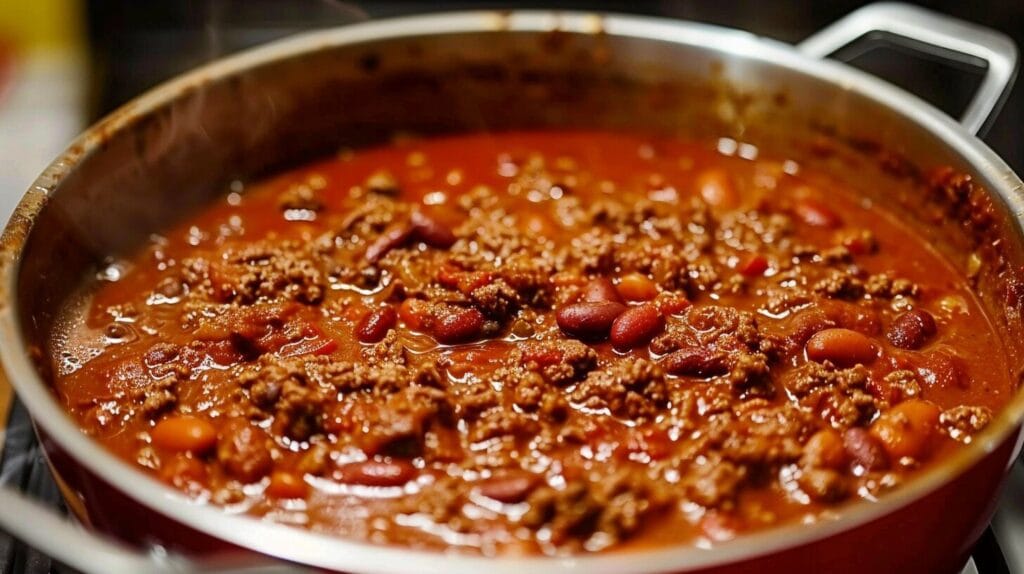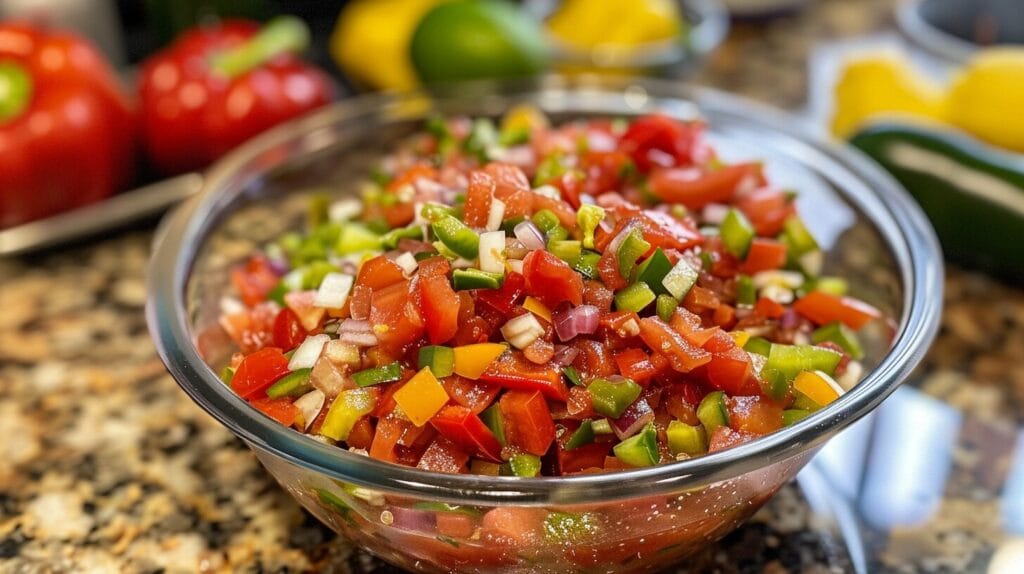How do you reduce sodium in canned chili? Canned chili is a quick, convenient, and delicious meal option but often has a downside – high sodium content. While sodium helps with preservation and flavor, consuming too much can have significant health implications. Fortunately, several effective ways exist to lower the sodium levels in canned chili without sacrificing taste.
This guide will explore why canned chili is high in sodium, the health risks associated with excessive sodium intake, and practical strategies to reduce sodium at home. Whether you’re looking to manage your blood pressure or eat healthier, this guide will equip you with the tools to enjoy your favorite canned chili in a heart-friendly way.
Let’s dive into why the high sodium content is high and how to start reducing it today.
Table of Contents
Why is Canned Chili High in Sodium?
Processing Methods that Increase Sodium in Canned Chili
Canned chili undergoes extensive processing to ensure it remains shelf-stable for months or even years. One of the key aspects of this preservation process is sodium. Sodium is a preservative, preventing bacterial growth and maintaining the chili’s texture and flavor over time. Salt is often added in large quantities during manufacturing to enhance taste and prolong shelf life.

In addition to salt, other sodium-containing preservatives, such as sodium nitrate or sodium benzoate, are frequently used to extend the product’s longevity. While these methods effectively prevent spoilage, they significantly contribute to the overall sodium content in canned chili.
Preservative Role of Sodium in Canned Chili
Salt is more than just a flavor enhancer – it’s a critical element in food preservation. Sodium draws moisture out of the food, creating an environment that inhibits bacterial growth. In canned chili, this means that not only is the chili safe to eat long after packaging, but the texture of the beans and meat remains intact.
However, this comes at a cost to health. A single serving of canned chili can contain up to 1,000 milligrams of sodium – nearly half the recommended daily intake for adults. Consuming canned products frequently can lead to excessive sodium consumption, which may result in various health issues over time.
Health Risks of High Sodium in Canned Chili
Hypertension and Heart Health from Canned Chili
One of the most significant risks of consuming too much sodium is the development of high blood pressure (hypertension). Excess sodium in the bloodstream pulls water into your blood vessels, increasing blood volume. This elevated blood volume puts extra pressure on your heart and arteries, which can eventually lead to heart disease, strokes, and other cardiovascular problems.
According to the American Heart Association, reducing sodium intake can lower blood pressure and decrease the risk of heart-related complications. If canned chili is a regular part of your diet, reducing its sodium content can be a simple yet impactful way to protect your heart.
Impact on Kidneys and Bloating Due to High-Sodium Chili
The kidneys play a crucial function in controlling sodium levels within the body. When sodium intake is too high, the kidneys must work harder to expel the excess, potentially leading to kidney damage over time. High sodium levels can also lead to fluid retention, causing bloating and swelling, often called edema.
Reducing sodium helps alleviate this kidney strain and minimizes bloating, improving health and comfort. Reducing sodium is essential for individuals with kidney disease to avoid further complications.

How Do You Reduce Sodium in Canned Chili? Simple Techniques
How Do You Reduce Sodium in Canned Chili by Rinsing and Draining?
One of the easiest and most effective ways to reduce sodium in canned chili is by rinsing and draining it. Pour the chili into a colander and rinse it under cold running water for about 30 seconds. This process can wash away a significant portion of the sodium-rich sauce while retaining solid ingredients like beans and meat.
Studies have shown that rinsing canned foods can reduce sodium content by up to 40%. Although this may slightly diminish the chili’s flavor, it provides a healthier base you can season using low-sodium spices and herbs.
How Do You Reduce Sodium in Canned Chili with Low-Sodium Ingredients?
Another simple method to reduce sodium is diluting the canned chili with low-sodium ingredients. Adding no-salt-added beans, tomatoes, or vegetables can stretch the dish, effectively lowering the sodium concentration per serving. This reduces sodium and increases the volume of your meal, making it more filling and nutritious.
Mix the canned chili with a low-sodium broth or water to further dilute the saltiness. Simmering the chili for a few minutes after adding these ingredients helps blend the flavors, ensuring a rich and hearty dish.
Adding Fresh Vegetables
Incorporating fresh vegetables like bell peppers, onions, carrots, or zucchini can help absorb and balance the saltiness of canned chili. Vegetables are naturally low in sodium and high in fiber, which enhances the nutritional value of the meal.
Chop the vegetables finely and sauté them before mixing them with the canned chili. This improves flavor and adds a delightful texture that makes the dish more vibrant and satisfying.
Using Low-Sodium Broth
Replacing part of the canned chili sauce with low-sodium broth is another effective trick. This technique works particularly well if the chili is too thick or salty. Gradually add the broth while heating the chili, stirring well to ensure the flavors meld together.
Low-sodium vegetable or chicken broth can enhance the taste without overpowering the original chili flavors. This method reduces overall sodium without losing the dish’s essence.
Cooking Modifications
Homemade Flavor Enhancers
Reducing sodium doesn’t mean sacrificing flavor. By incorporating natural, sodium-free flavor enhancers, you can bring out the best in canned chili without relying on salt. Ingredients like garlic, onions, and roasted peppers add depth and richness to chili. You can also experiment with mushrooms, which provide an umami taste similar to salt. You create a more complex flavor profile by sautéing these ingredients and adding them to the chili.
Herbs and Spices
Herbs and spices are excellent alternatives to salt. Use cumin, paprika, chili powder, black pepper, and smoked paprika to season your chili. These spices add bold flavors that complement the existing taste of canned chili.
Fresh herbs like cilantro, parsley, and oregano can provide a bright, fresh touch. Dried herbs, such as thyme or rosemary, work well during the simmering process, infusing the dish with savory notes.
Try blending different spices to find a combination that suits your preferences. This approach enhances flavor naturally, making canned chili taste homemade and gourmet.
Vinegar and Citrus Juice
Acidity can counterbalance saltiness, making vinegar and citrus juice essential tools in low-sodium cooking. A splash of apple cider vinegar, white vinegar, or lime juice can brighten the chili’s flavor, cutting through the salt without overpowering the dish.
Citrus zest can also add a refreshing kick. Sprinkle lemon or lime zest over the chili before serving to enhance its complexity and reduce salt perception.
Reducing Use of Salt-Based Seasoning
Avoid adding table salt or pre-mixed chili seasoning blends that often contain high sodium levels. Instead, opt for homemade spice blends using sodium-free ingredients.
If you enjoy a bit of heat, use chili flakes or fresh jalapeños to intensify the spice level. Spicy flavors can distract the palate from the lower sodium content, making the dish more exciting.
Choosing Low-Sodium Canned Chili
Reading Nutrition Labels
When selecting canned chili, the first step is to carefully check the nutrition label. Look for the sodium content per serving – ideally, choose products labeled “low sodium” or “no salt added.”
A low-sodium product typically contains 140 mg of sodium or less per serving. In contrast, regular canned chili can have anywhere from 700 to 1,000 mg per serving. You can significantly reduce your daily sodium intake by opting for low-sodium versions.
Pay attention to serving sizes, as some cans may list smaller serving portions to make the sodium content appear lower. Compare similar products to find the one with the least sodium per ounce.
Recognizing Low-Sodium Brands
Several brands focus on providing healthier, low-sodium alternatives to classic canned chili. Look for trusted names such as:
- Amy’s Organic – Known for organic, low-sodium chili varieties.
- Health Valley – Offers no-salt-added canned chili.
- Eden Foods – Specializes in low-sodium, organic canned beans and chili options.
- Trader Joe’s – Carries reduced-sodium chili options.
These brands prioritize minimal sodium without compromising flavor, making them excellent choices for health-conscious consumers.
DIY Chili for Sodium Control
Homemade Chili Recipe
Making chili from scratch is the most effective way to control sodium levels. You can eliminate unnecessary salt by choosing fresh, whole ingredients while maximizing flavor. Here’s a simple, low-sodium chili recipe that’s hearty and delicious.
Ingredients:
- 1 lb lean ground turkey or beef (optional: for vegetarians, use lentils or mushrooms)
- 1 large onion, diced
- 3 cloves garlic, minced
- 1 red bell pepper, diced
- 1 zucchini, chopped
- 2 carrots, diced
- 1 can (15 oz) no-salt-added diced tomatoes
- 1 can (15 1 oz) kidney beans with no salt added (rinsed and draining)
- 1 can (15 1 oz) black beans (rinsed and draining)
- 2 cups low-sodium vegetable or chicken broth
- 1 tbsp tomato paste
- 2 tsp cumin
- 2 tsp chili powder
- 1 tsp smoked paprika
- ½ tsp black pepper
- ½ tsp oregano
- Juice of 1 lime
- Fresh cilantro for garnish
Instructions:
- Cook the vegetables in a large pot. Prepare one tablespoon of olive oil on medium heat. Add the onion, garlic, bell pepper, zucchini, and carrots. Cook for 5-7 minutes until softened.
- Cook the Meat (Optional) – Add ground meat to the pot and cook until browned. Drain any excess fat.
- Add Beans and Tomatoes – Stir in the rinsed beans, diced tomatoes, and tomato paste. Mix well.
- Season the Chili – Add cumin, chili powder, smoked paprika, black pepper, and oregano. Stir to combine.
- Simmer – Pour in the low-sodium broth and bring to a boil. Reduce heat and let it simmer for 30-45 minutes, stirring occasionally.
- Finish with Lime – Just before serving, squeeze fresh lime juice over the chili and garnish with cilantro.
This homemade chili is rich in flavor without relying on salt. The variety of vegetables and beans makes it a nutrient-dense, satisfying meal.
Benefits of Lower-Sodium Chili
Improved Heart Health
Reducing sodium intake can have a significant positive impact on heart health. Lowering sodium in canned chili or making a homemade low-sodium version reduces the risk of hypertension, heart disease, and stroke. Less sodium means your heart doesn’t have to work as hard, promoting better circulation and overall cardiovascular health.
Over time, consistently choosing low-sodium meals can lead to lasting improvements in blood pressure, which helps decrease the likelihood of heart-related complications. Small changes, like cutting sodium in canned chili, contribute to long-term wellness.
Enhanced Flavor Without Salt
A common misconception is that low-sodium meals lack flavor. Reducing salt forces you to get creative with other taste enhancers, leading to more prosperous and complex flavors. Spices, herbs, citrus, and vinegar add layers of flavor that salt alone can’t provide.
By experimenting with various seasoning blends, you can develop a chili recipe that’s uniquely yours – full of bold, vibrant flavors without relying on sodium. This approach not only improves taste but also enhances your overall cooking skills.
Better Hydration and Less Bloating
Excess sodium often leads to water retention and bloating. Lowering sodium in your chili, you can avoid that uncomfortable, sluggish feeling after meals. Reducing salt intake helps maintain fluid balance, keeping you hydrated and energized.
Additionally, cutting back on sodium supports kidney function, making it easier for your body to filter and expel excess fluids. This can be particularly beneficial for individuals with kidney issues or those prone to bloating.
Frequently Asked Questions (FAQ):
Can rinsing canned chili reduce sodium?
Yes, rinsing canned chili can reduce sodium by up to 40%. Pour the chili into a colander and rinse it under cold water for 30 seconds. This helps wash away sodium-heavy sauce while preserving solid ingredients like beans and meat. For more ideas on balancing flavors, check out this low-sodium chili recipe that offers a heart-healthy alternative.
How much sodium is safe to consume daily?
The American Heart Association recommends limiting sodium intake to 2,300 mg daily, with an ideal target of 1,500 mg for most adults. Consuming less sodium can significantly lower the risk of high blood pressure and cardiovascular issues. If you’re interested in reducing salt in other dishes, try this guide on how to make your baking powder, a common pantry swap that avoids added sodium.
What ingredients reduce saltiness in chili?
To counteract saltiness in chili, try adding:
Acidic ingredients – Lime juice, vinegar, or lemon juice can balance excess salt.
Sweeteners – A small amount of honey, sugar, or maple syrup can offset saltiness.
Potatoes – Adding diced potatoes while simmering absorbs excess salt. Remove them before serving (learn more about using potatoes to reduce salt).
Vegetables and broth – Adding fresh vegetables or low-sodium broth can dilute the dish.
Are low-sodium canned chili options tasty?
Yes! Many brands offer low-sodium canned chili that retains flavor using fresh spices, herbs, and quality ingredients. Brands like Amy’s Organic and Health Valley provide flavorful, reduced-sodium options that taste just as satisfying as their regular counterparts. Check out this dense bean salad recipe, a delicious low-sodium side dish, for more ideas.
How can I make chili flavorful without salt?
Enhance the flavor with:
- Spices – Cumin, smoked paprika, chili powder, and black pepper.
- Herbs – Fresh cilantro, oregano, and parsley.
- Aromatics – Garlic, onions, and roasted peppers.
- Acid – A squeeze of lime or splash of vinegar adds brightness and cuts through blandness. Explore how different spices elevate flavor without added sodium.
What are the best salt alternatives for chili?
Some great sodium-free alternatives include:
- Nutritional yeast – Adds a cheesy, umami flavor.
- Smoked paprika – Delivers a smoky, deep taste.
- Garlic powder – Boosts savory notes.
- Lemon zest – Brightens the dish naturally.
Conclusion
Reducing sodium in canned chili is easier than you might think, and the health benefits make it well worth the effort. You can transform canned chili into a heart-healthy, flavorful meal by rinsing and draining, adding fresh vegetables, using low-sodium broth, and incorporating bold spices and herbs.
If you prefer complete control over sodium intake, make chili from scratch using no-salt-added ingredients. This approach enhances the nutritional profile and allows you to experiment with flavors that suit your taste buds.
Cutting back on sodium doesn’t mean giving up on delicious meals. With a few simple adjustments, you can enjoy just as satisfying chili – and far better for your overall well-being. Start making these small changes today, and your body will thank you!
